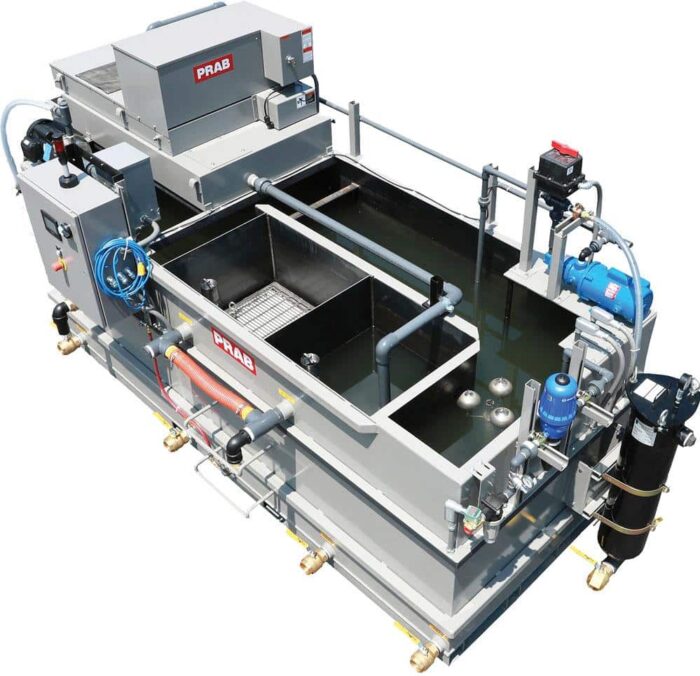
Between the skilled labor shortage and the recent economic turmoil, manufacturers are constantly tasking employees with greater challenges, making it critical to identify opportunities that will allow them to run facilities as efficiently as possible.
Proactively approaching operation improvements can have several long-term benefits, especially during challenging market conditions. One operational improvement to consider is streamlining cutting-fluid management with advanced, automated systems.
These systems continuously remove tramp oils and suspended solids from contaminated cutting fluid, control bacteria, and can adjust fluid concentration, enabling the fluid to be recovered and returned to service.
Advanced automated fluid management systems minimize operator intervention, yield lower annual fluid replacement costs and haul-away expenses, and extend tool life – all while improving part quality and maximizing uptime.
Centralized systems for recycling used cutting fluid can reduce fluid waste up to 90%, lower new fluid purchase costs up to 75%, and extend tool life up to 25%. In addition, automation during the process minimizes manual intervention and allows the workforce to focus on other tasks.
Minimize Operator Intervention
Even before the 2020 economic downturn, multiple studies showed the skills gap could cause an estimated 2.5 million manufacturing jobs to go unfilled. Considering ongoing operational challenges, facilities must also rethink work cell layouts to ensure fewer people are concentrated in a particular workspace. This highlights the importance of finding opportunities in which automation makes practical and financial sense.
Turnkey recycling systems, such as PRAB’s Guardian, are easy to operate and require minimal operator involvement and training. Systems constantly work and feed uncontaminated cutting fluid onto tools, allowing existing personnel to allocate attention to other tasks.
A new option, automatic coolant concentration control, uses an economical in-line process refractometer. Instead of interrupting the process, the system’s embedded processor tests for Brix continuously. Such systems control concentration ratio to ±1%. When the levels drop below the required ratio, the system adds more chemicals and less water to bring the level back up and vice-versa.
Systems such as Guardian also provide a healthier work environment for employees by reducing sump maintenance and removing tramp oils and suspended solids from contaminated cutting fluid, limiting exposure to lubricants that could potentially cause health problems and lead to medical claims.
Labor-focused efficiencies are only part of why automated fluid filtration systems typically have a return on investment (ROI) within nine months. Advanced systems can significantly lower fluid costs and haul-away expenses while maintaining higher quality cutting fluid for a longer period – extending the life of the cutting fluid 2x-to-5x.
Valuable options for these recycling systems include coolant managers – ozone injection modules prevent rancidity, a major cause of cutting-fluid failure. This bacteria-control system eliminates the need for biocide and is a safe, economical way to kill bacteria, yeast, fungus, and mold. In addition, foul odors and skin irritations decline.
One manufacturer saw a significant decrease in the amount of haul-away waste after installing an advanced recycling system. Their previous recycling system consumed 4 drums (832L) of new cutting fluid oil and disposed of 4,500L every seven-to-eight days. With an advanced system, the company consumes that amount of new cutting fluid every 28 days and disposes of the same amount of waste every 83 days.
By reducing waste fluids up to 90%, costs to haul away hazardous waste can be lowered dramatically and help with the system’s ROI.
Protecting high-level capital investments can have a direct impact on a manufacturer’s financial health. Cutting tools can account for 3%-to-5% of total manufacturing costs for some operations.
Cutting fluid management is a major driver for extending the longevity of tool life. One worldwide manufacturer of complex metal components experienced dramatic increases in tool life from the automated filtration of its cutting fluid, including:
Extending cutting tool lifespans and more efficiently using cutting fluid can earn the payback in less than a year.
By investing in back-end equipment, manufacturers can efficiently reallocate labor, often their largest operational expense, more effectively and efficiently. A proactive approach to operational improvements, such as advanced recycling systems, can be especially helpful for shop managers trying to reduce financial strains during difficult market conditions.
This editorial was originally published in Today’s Motor Vehicles.